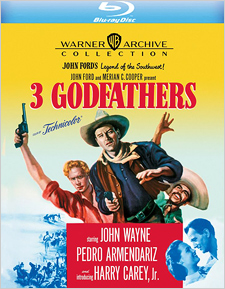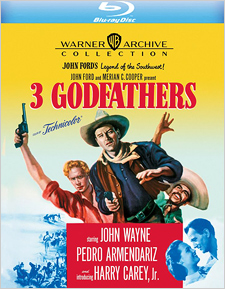3 Godfathers (Blu-ray Review)

Director
John FordRelease Date(s)
1948 (March 26, 2024)Studio(s)
Argosy Pictures/Metro-Goldwyn-Mayer (Warner Archive Collection)- Film/Program Grade: See Below
- Video Grade: See Below
- Audio Grade: See Below
- Extras Grade: N/A
- Overall Grade: A
Review
John Ford’s 1948 film 3 Godfathers wasn’t the first version of Peter B. Kyne’s 1913 story The Three Godfathers, and it wasn’t even Ford’s first pass at it, either—it’s actually a remake of his own remake. Excluding short subjects, the first feature film version was Edward LeSaint’s Three Godfathers in 1916, starring Harry Carey, Sr. (hold onto that thought for a moment). Ford remade it three years later as Marked Men, also starring Harry Carey, Sr. (don’t let go of the thought yet). Unfortunately, like far too many silent films, both Three Godfathers and Marked Men are now considered to be lost. The first sound version was William Wyler’s Hell’s Heroes in 1929 starring Charles Bickford (which was skewered a year later by Walter Lantz in the Oswald the Lucky Rabbit short Hell’s Heels). Richard Boleslawski’s Three Godfathers followed suit in 1936, and it’s effectively a direct remake of Hell’s Heroes, borrowing not just the basic structure of Kyne’s story, but also many of the specific details from Wyler’s film. John Ford reworked all of the elements from the preceding versions in 3 Godfathers, but even he didn’t get to have the last word on the subject: the late great Satoshi Kon reworked them even more radically decades later in his penultimate anime Tokyo Godfathers.
What is it about Kyne’s story that has been so irresistible to such a wide variety of filmmakers—enough so that Ford even assayed it not once, but twice? The broad contours of the story are thus: during the Christmas season, four bad men rob an Arizona bank, killing an innocent victim in the process, but one of them is also killed and another one wounded. The three surviving robbers flee into the desert while being pursued by the local sheriff. They’re desperately searching for a source of water, but they end up finding a wagon instead, where a dying woman is giving birth. She asks them to be godfathers to the child and to keep him safe whatever it may take. These formerly bad men decide to keep their promise to her and get the baby to New Jerusalem, by any means necessary.
While Kyne named his three godfathers Tom Gibbons, Bill Kearney, and Bob Sangster, he refers to them throughout as The Worst Bad Man, The Wounded Bad Man, and The Youngest Bad Man. If the Christmas setting hadn’t already made it patently obvious that this is going to be an allegorical tale of redemption, the naming convention definitely hammers the point home. That’s likely the main reason why the story has proved so appealing throughout the years. It’s easy to play around with the details and even the setting, but the core concept of three ne’er-do-wells learning how to sacrifice themselves in order to save the life of one innocent infant is an irresistible one, and the Christmas setting is just the icing on the cake. (For anyone interested in assaying the story that started it all, the Project Guttenberg website has Kyne’s full text accompanied by reproductions of Dean Cornwell’s illustrations from the 1922 Cosmopolitan Book Corporation edition.)
The screenplay for 3 Godfathers was by Laurence Stalling and John Ford stalwart Frank S. Nugent. They made some pretty significant changes to Kyne’s story and from most of the previous adaptations as well. The tone has been softened considerably, with no fourth bad man dying at the start, and the three bad men don’t kill anyone else during the robbery, either. A few roles have been swapped; the fourth bad man in the 1936 version was a Mexican-American named Pedro, but this time Pedro has graduated into being one of the three survivors who are offered a chance at redemption. Everything is sprinkled with liberal doses of the broad Irish humor and open sentimentality that was especially prominent in Ford’s films from the period—in that respect, 3 Godfathers and the following year’s She Wore a Yellow Ribbon are two peas in a pod. Yet the biggest change is in the way that the story wraps up during the finale; there’s no final sacrifice like in Hell’s Heroes and the 1916 Three Godfathers, plus there’s also an extended coda that goes far beyond what Kyne originally conceived.
Yet however much that Laurence Stalling and Frank S. Nugent may have gilded the John Ford lily by adding so much humor, sentimentality, and religiosity, John Ford also gilded his own lily in terms of the casting. The familiar Ford faces on display include John Wayne in the Sangster role (rechristened Robert Marmaduke Sangster Hightower here), even if he’s not actually The Youngest Bad Man in this case. That honor goes to Harry Carey, Jr. as Kearney, who’s still The Wounded Man in terms of the story. The trio is rounded out by Pedro Armendáriz as Pedro Roca Fuerte, who is far from being The Worst Bad Man in this particular iteration. They’re all counterbalanced perfectly by Ward Bond as Sheriff Perley “Buck” Sweet. There’s an appealing Balance of Terror style battle of the wits throughout the film between Hightower and Sweet, something that pays off handsomely during the finale when Sweet gets to face off against Hightower in the way that Sweet fervently desired.
The rest of the cast is filled with other Ford veterans. Mildred Natwick plays the child’s mother, and Sheriff Sweet’s posse includes the likes of Ben Johnson, Hank Worden, Jack Pennick, and Cliff Lyons. Jane Darwell also is on hand to steal scenes with her usual abandon—she’s large as life and twice as natural in this film. Even Mae Marsh, who’s seen briefly as Sweet’s wife, had made several uncredited appearances in earlier Ford film. The most obvious omission is Victor McLaglen, but honestly, there wouldn’t really have been a good role for him anyway. In all other respects, the cast of 3 Godfathers is pure John Ford stock company.
That includes someone who doesn’t make an appearance in the film, but who cast a long shadow over it anyway: Harry Carey, Sr. He passed away late in 1947, and Ford dedicated 3 Godfathers to him during the opening titles, calling him the “Bright Star of the Early Western Sky.” (Thanks for holding onto that thought for so long.) He’s still there in spirit in the form of his son Harry Carey, Jr., who’s given an “And Introducing...” credit. Yet in the words of Edgar Buchanan in The Comancheros, that’s just a plain, dumb blasted lie. He’d actually made several appearances prior to this, including one for Howard Hawks earlier that year in Red River. Yet it’s still perfectly appropriate to offer him his “official” introduction in the same film that’s dedicated to his father’s memory. It’s pure sentimentality, and in many respects, 3 Godfathers is the purest expression of John Ford’s own sentimental nature. Casual viewers may find it a little off-putting, but dedicated Ford fans will welcome all the of schmaltz in 3 Godfathers with open arms.
Cinematographer Winton Hoch shot 3 Godfathers on 35mm film in three-strip Technicolor using spherical lenses, framed at the full Academy aperture of 1.37:1 for its theatrical release. This version is described as a “new 4K restoration from the original camera negative,” with no other information available, but it’s the usual stellar work from Warner Bros. Motion Picture Imaging (MPI). The image is pristine, without any traces of damage remaining, and there are no signs of color fringing or any other registration issues due to combining the three separate negatives. No stability or density issues, either. The grain has been softened a bit, but before anyone screams “DNR!”, keep in mind that mild grain reduction must be applied to three-strip Technicolor productions in order to prevent them from becoming an unwatchable, swarming mess. You can’t overlay three separate grain fields without doing something to smooth them out. Originally, that happened naturally due to the generational loss from the printing process, so there needs to be a digital equivalent in modern home video versions. Needless to say, MPI nailed it here, and the results perfectly replicate the velvety look of a Technicolor print. As far as those colors go, they’re pretty much perfect, as is the contrast range. There’s little that could be done to improve on this Blu-ray presentation of 3 Godfathers—even a 4K version wouldn’t offer much more in terms of fine detail, and the bold nature of Technicolor doesn’t really require the refinement of an HDR grade.
Audio is offered in English 2.0 mono DTS-HD Master Audio, with optional English SDH subtitles. The sound is fairly robust for a 1948 film, and even Richard Hageman’s score is clear and free from distortion. There’s no crackling or popping, and while there’s still a hint of background noise, it’s not too distracting.
3 GODFATHERS (FILM/VIDEO/AUDIO): B+/A/B+
The following extras are included in HD:
- 3 Godfathers Original Theatrical Trailer (3:20)
- Three Godfathers (1936) (80:59)
- Three Godfathers Original Theatrical Trailer (1:59)
Three Godfathers is the 1936 version of the story, starring Chester Morris, Lewis Stone, Walter Brennan, Irene Hervey, Roger Imhof, and Joseph Marievsky. It’s another example of the way that the broad canvas of Peter B. Kyne’s story allows for a variety of different kinds of individual expression along the way. The basic story beats are still recognizable, but there’s none of John Ford’s humor or his sentimentality. Naturally, the Christmas angle is retained, but the religious elements have been downplayed. While it’s understandable that Three Godfathers has long been overshadowed by Ford’s version, it’s still well worth a look, and the high contrast black-and-white cinematography by Joseph Ruttenberg provides an interesting counterpoint to Hoch’s vivid Technicolor work. It hasn’t been shortchanged here, either, as it’s presented in a “4K restoration of the best preservation elements.” Presumably that means that the original nitrate negative is long gone, but whatever dupe elements were used, MPI still wrung the best out of them. The results aren’t quite as pristine as 3 Godfathers, and there are some inconsistencies due to the fact that there were probably multiple source elements used, but it’s still nicely detailed with an excellent grayscale, contrast, and black levels. The audio is also offered in English 2.0 mono DTS-HD Master Audio, and it’s a bit noisier than 3 Godfathers, but still relatively clear.
THREE GODFATHERS (FILM/VIDEO/AUDIO): B-/A-/B-
In terms of assigning a grade for the extras, that’s a little complicated in this case. While Three Godfathers is included under the Special Features sub-menu on the disc, the two trailers are the only things that could properly be considered extras, which normally would result in a low rating like a D-. Yet if you do decide to count the 1936 version Three Godfathers as an “extra,” then the grade should be much higher. In reality, though, this is really a double feature of the two films that only includes the trailers as extras. It’s just not authored that way on the disc. So, I’m going to waffle a bit by giving a miss to the extras grade and just giving the overall package an A instead. (Don’t kid yourselves: sometimes, we overthink things like this to death.) In any event, this is an incredible Blu-ray release from Warner Archive, and it belongs on the shelf of every John Wayne fan, John Ford fan, western fan, three-strip technicolor fan, and pretty much every other classic film fan as well. You probably fall into one or more of those categories, so just buy 3 Godfathers. You won’t regret it.
- Stephen Bjork
(You can follow Stephen on social media at these links: Twitter and Facebook.)

